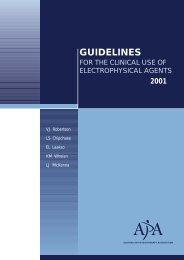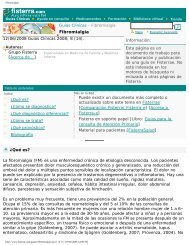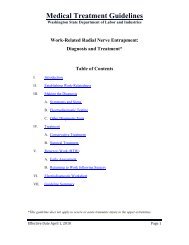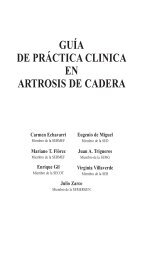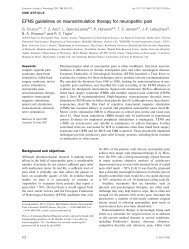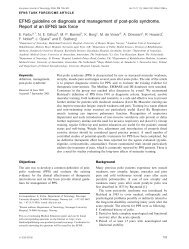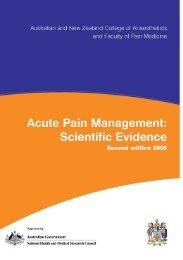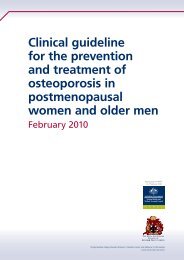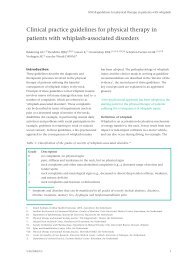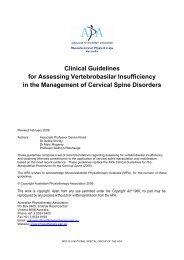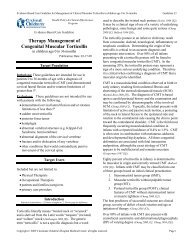<strong>Practice</strong> <strong>Parameter</strong>: Carpal Tunnel SyndromeComparison <strong>of</strong> Sensitivity <strong>of</strong> Different EDX StudiesBased on <strong>the</strong> data reviewed in <strong>the</strong> Results, median sensory<strong>and</strong> motor nerve CV studies including comparison <strong>of</strong>median sensory conduction to ulnar <strong>and</strong> radial sensoryconduction in <strong>the</strong> same h<strong>and</strong> are more sensitive <strong>and</strong> specificfor <strong>the</strong> diagnosis <strong>of</strong> CTS than measurements <strong>of</strong> (1) medianSNAP amplitudes <strong>and</strong> amplitude ratios, (2) motor CMAPamplitudes <strong>and</strong> amplitude ratios, (3) F-wave parameters, <strong>and</strong>(4) sympa<strong>the</strong>tic skin responses.Several studies that met 4 or more <strong>of</strong> <strong>the</strong> 6 AAEM CTS LICcompared <strong>the</strong> relative sensitivity <strong>of</strong> different tests <strong>of</strong> mediansensory conduction, median motor conduction, <strong>and</strong> needleEMG in CTS patients.In 4 <strong>of</strong> 4 recent (after 1980) studies <strong>of</strong> patients with CTS,NCSs showed abnormalities more <strong>of</strong>ten than needle EMG<strong>of</strong> <strong>the</strong> APB muscle (Kimura <strong>and</strong> Ayyar, 131 Jackson <strong>and</strong>Clifford, 110 Seror, 228 <strong>and</strong> Kuntzer. 140 )In 23 <strong>of</strong> 29 studies <strong>of</strong> CTS patients, median sensory NCSswere abnormal more frequently than motorNCSs. 31,47,57,91,110,125,128,131,135,140,159,167,171,174,188,189,200,206,214,220,221,226,228,233,237,249,253,254,255 The 2 studies published before1990 that were exceptions may reflect a small sample <strong>of</strong>patients (20 h<strong>and</strong>s <strong>of</strong> 13 patients), 128 <strong>and</strong> a low threshold(3.7 ms) for an abnormal median motor distal latency, 110 (<strong>the</strong>latter information was obtained by written communicationfrom <strong>the</strong> author <strong>and</strong> was not included in <strong>the</strong> original report).The 4 studies published since 1990 that were exceptionshave suggested that computation <strong>of</strong> <strong>the</strong> median terminallatency index (Simovic <strong>and</strong> Weinberg 237 ) <strong>and</strong> comparison<strong>of</strong> <strong>the</strong> second lumbrical (median) <strong>and</strong> interossei (ulnar)distal motor latency difference has a test sensitivity equal orgreater than median sensory conduction (Preston <strong>and</strong>Logigian, 200 Sheean, 233 <strong>and</strong> Trojaborg 253 ). However, <strong>the</strong>selatter median/ulnar lumbrical/interossei test findings werenot confirmed in <strong>the</strong> study by Uncini 254 that met all 6AAEM CTS LIC.In 19 <strong>of</strong> 19 studies <strong>of</strong> patients with CTS, median mixedNCSs from <strong>the</strong> palm to <strong>the</strong> wrist (e.g., 8 cm conductiondistance) were abnormal more frequently than mediansensory NCSs from <strong>the</strong> digit to <strong>the</strong> wrist (e.g., 13 cm to 14cm conduction distance). 9,31,57,59,71,110,128,131,132,140,173,188,189,200,214,221,228,233,237 These 19 studies included <strong>the</strong> 7 reports thatmet 6 AAEM CTS LIC by Jackson <strong>and</strong> Clifford, 110Kimura, 132 Padua <strong>and</strong> colleagues, 188,189 Scelsa <strong>and</strong>colleagues, 221 Di Guglielmo <strong>and</strong> colleagues, 59 <strong>and</strong>Kuntzer 140 which are summarized in Tables 11 <strong>and</strong> 12.In 20 <strong>of</strong> 20 studies <strong>of</strong> patients with CTS, comparison <strong>of</strong>median sensory/mixed nerve conduction to ulnarsensory/mixed nerve conduction or radial sensory nerveconduction in <strong>the</strong> same limb <strong>of</strong> CTS patients were abnormalmore frequently than evaluation <strong>of</strong> median sensory NCSsfrom wrist to digit alone. 9,38,45,47,57,63,110,116,140,143,148,171,173,174,188,189,192,228,237,248,254,255 These 20 studies included <strong>the</strong> 6reports that met 6 AAEM CTS LIC by Carroll, 38 Jackson<strong>and</strong> Clifford, 110 Kuntzer, 140 Padua <strong>and</strong> colleagues, 188,189 <strong>and</strong>Uncini <strong>and</strong> colleagues 254 which are summarized in Tables 9,17, 18, 19, <strong>and</strong> 20.The pooled sensitivity <strong>of</strong> <strong>the</strong> several tests evaluated isshown in Table 22 (data analysis by Gary Gronseth, MD).The data in <strong>the</strong> appropriate table for each study weresubjected to a meta-analysis with 95% confidence limits totake into account <strong>the</strong> fact that some <strong>of</strong> <strong>the</strong> studies includedmore CTS patients than o<strong>the</strong>r studies. CONCLUSIONSThis report provides convincing scientific evidence thatmedian sensory <strong>and</strong> motor NCSs:1. Are valid <strong>and</strong> reproducible clinical laboratorystudies.2. Confirm a clinical diagnosis <strong>of</strong> CTS with a highdegree <strong>of</strong> sensitivity (>85%) <strong>and</strong> specificity(>95%).The sensitivities <strong>of</strong> <strong>the</strong> several different median NCSs werecompared. The comparison demonstrated that:1. Median sensory NCSs confirm <strong>the</strong> clinicaldiagnosis <strong>of</strong> CTS more <strong>of</strong>ten than median motorNCSs (63% to 69% versus 65% to 85%: Tables3, 11, 12, 18, 19, 20, <strong>and</strong> 22).or2. The median sensory or mixed nerve conductionfrom wrist to digit (conduction distance 13 to 14cm) is less sensitive (65%: Tables 11<strong>and</strong> 22) forconfirmation <strong>of</strong> <strong>the</strong> clinical diagnosis <strong>of</strong> CTScompared to:a. Techniques which evaluate median sensoryor mixed nerve conduction over a short (7 to8 cm) conduction distance across <strong>the</strong> carpaltunnel (e.g., palmar studies 74%: Tables 12<strong>and</strong> 22); orb. Techniques which compare sensory ormixed nerve conduction <strong>of</strong> <strong>the</strong> median nervethrough <strong>the</strong> carpal tunnel to sensory ormixed nerve conduction <strong>of</strong> <strong>the</strong> ulnar nerve(85%: Tables 18, 19, <strong>and</strong> 22) or radial nerve(65%: Tables 20 <strong>and</strong> 22) in <strong>the</strong> same h<strong>and</strong>;c. Techniques which compare sensory or mixednerve conduction <strong>of</strong> <strong>the</strong> median nerve through<strong>the</strong> carpal tunnel to sensory or mixed NCSs <strong>of</strong>proximal (forearm) <strong>and</strong> distal (digit) segments<strong>of</strong> <strong>the</strong> median nerve in <strong>the</strong> same limb (85%:Tables 16 <strong>and</strong> 22).S954 CTS <strong>Literature</strong> <strong>Review</strong>© 2002 American Association <strong>of</strong> Electrodiagnostic Medicine
<strong>Practice</strong> <strong>Parameter</strong>: Carpal Tunnel SyndromeTable 22. Comparison <strong>of</strong> Pooled Sensitivities <strong>and</strong> Specificities<strong>of</strong> EDX Techniques to Diagnose CTS.TechniquePooledSensitivity*A Median sensory <strong>and</strong> mixed nerve conduction: wrist <strong>and</strong>0.85†palm segment compared to forearm or digit segment(0.83,0.88)B Comparison <strong>of</strong> median <strong>and</strong> ulnar sensory conduction0.85Between wrist <strong>and</strong> ring finger(0.80,0.90)C Median sensory <strong>and</strong> mixed nerve conduction0.74†Between wrist <strong>and</strong> palm(0.71,0.76)D Comparison <strong>of</strong> median <strong>and</strong> ulnar mixed nerve0.71Conduction between wrist <strong>and</strong> palm(0.65,0.77)E Median motor nerve conduction0.69†Between wrist <strong>and</strong> palm(0.64,0.74)F Comparison <strong>of</strong> median <strong>and</strong> radial sensory conduction0.65Between wrist <strong>and</strong> thumb(0.60,0.71)G Median sensory nerve conduction0.65†Between wrist <strong>and</strong> digit(0.63,0.67)H Median motor nerve distal latency 0.63†(0.61,0.65)I Median motor nerve terminal latency index 0.62†(0.54,0.70)J Comparison <strong>of</strong> median motor nerve distal latency (second0.56‡lumbrical) to <strong>the</strong> ulnar motor nerve distal latency (second (0.46,0.66)interossei)K Sympa<strong>the</strong>tic skin response 0.04PooledSpecificity*0.98†(0.94,1.00)0.97(0.91,0.99)0.97†(0.95,0.99)0.97(0.91,0.99)0.98†(0.93,0.99)0.99(0.96,1.00)0.98†(0.97,0.99)0.98†(0.96,0.99)0.94†(0.87,0.97)0.98‡(0.90,1.00)0.52(0.44,0.61)(0.00,0.08)* For each EDX technique to summarize results across studies, sensitivities were pooled from individual studies by calculating aweighted average. In calculating <strong>the</strong> weighted average, studies enrolling more patients received more weight than studies enrollingfewer patients. Specificities were similarly pooled by calculating <strong>the</strong> weighted average. The data in <strong>the</strong> paren<strong>the</strong>ses below <strong>the</strong>sensitivity <strong>and</strong> specificity values represent <strong>the</strong> lower <strong>and</strong> upper 95% confidence limits <strong>of</strong> <strong>the</strong> weighted average, respectively. Dataanalysis courtesy <strong>of</strong> Dr. Gary Gronseth.† There was heterogeneity between some <strong>of</strong> <strong>the</strong> studies (<strong>the</strong> 95% confidence intervals <strong>of</strong> <strong>the</strong> sensitivities <strong>and</strong> specificities do notoverlap). This disparity may be related to differences in case definition <strong>of</strong> CTS, <strong>the</strong> use <strong>of</strong> different cut-points to define anabnormal value, <strong>and</strong> differences in <strong>the</strong> average severity <strong>of</strong> <strong>the</strong> CTS patients in <strong>the</strong> different studies.‡ Results based on a single study.RECOMMENDATIONS REGARDING EDXSTUDIES TO CONFIRM A CLINICALDIAGNOSIS OF CTSThe recommendations below are identical to those made<strong>and</strong> endorsed in 1993 7 by <strong>the</strong> AAN, <strong>the</strong> AAPMR, <strong>and</strong> <strong>the</strong>AAEM with <strong>the</strong> clarification <strong>of</strong> recommendation 1 <strong>and</strong> 2a<strong>and</strong> <strong>the</strong> addition <strong>of</strong> 2c based on new evidence reviewed in<strong>the</strong> second CTS <strong>Literature</strong> <strong>Review</strong>. 2 In patients suspected<strong>of</strong> positive CTS, <strong>the</strong> following EDX studies arerecommended (see Table 22 for sensitivity <strong>and</strong> specificity<strong>of</strong> Techniques A – K):1. Median sensory NCS across <strong>the</strong> wrist with aconduction distance <strong>of</strong> 13 to 14 cm(Technique G). If <strong>the</strong> result is abnormal,comparison <strong>of</strong> <strong>the</strong> result <strong>of</strong> <strong>the</strong> mediansensory NCS to <strong>the</strong> result <strong>of</strong> a sensory NCS<strong>of</strong> 1 o<strong>the</strong>r adjacent sensory nerve in <strong>the</strong>symptomatic limb (St<strong>and</strong>ard).2. If <strong>the</strong> initial median sensory NCS across <strong>the</strong>wrist has a conduction distance greater than8 cm <strong>and</strong> <strong>the</strong> result is normal, 1 <strong>of</strong> <strong>the</strong>following additional studies is recommended:a. Comparison <strong>of</strong> median sensory ormixed nerve conduction across <strong>the</strong> wristover a short (7 to 8 cm) conductiondistance (Technique C) with ulnarsensory nerve conduction across <strong>the</strong>wrist over <strong>the</strong> same short (7 to 8 cm)Muscle & Nerve Supplement X 2002 S955



